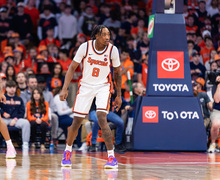International students at Syracuse University compare their home drinking habits to American ones
Sherri Liu | Contributing Illustrator
UPDATED: Oct. 3, 2016 at 6:37 p.m.
There are many international undergraduate students at Syracuse University who have felt the hangover of the prevalent college drinking culture.
Coming from all across the world, these students differ in their cultural backgrounds and assimilation into the university’s community. Yet, in interviews with eight international students, they share a common belief about the U.S. college drinking scene: American students binge drink recklessly and too often rely on getting “blackout drunk” to have fun.
Underage and under the influence
“Underage drinking is a big deal here … I find it ridiculous that most people can serve in the army and smoke cigarettes, but are not allowed to drink until they are 21,” said Alisa Sokolova, a sophomore in the College of Arts and Sciences who is from Moscow. “Those who want to drink will drink anyway.”
Of the countries that legalize alcohol consumption, the U.S. is one of 12 countries with the highest legal drinking age of 21, according to ProCon.org. Excessive drinking is one of the leading issues targeting its youth, and this can be felt nowhere more than on college campuses.
When the law is disobeyed so frequently and on such a large scale, many are quick to question its effectiveness.
The National Institute on Alcohol Abuse and Alcoholism (NIAAA) reports that almost 60 percent of college students ages 18 to 22 drank alcohol in the past month. Almost two out of three of them engaged in binge drinking during that same time frame.
The national drinking age aims to protect the American youth, but some SU students think this restriction may result in students being unprepared to deal with the pressures of the college drinking culture.
“Many Americans in freshman year don’t know how to drink. Whenever you went to the bathroom Friday or Saturday night, you would find people throwing up,” Sokolova said about her experiences at SU.
Countless freshmen arrive on campuses to find themselves surrounded by kegs of beer and bowls of jungle juice, a powerful concoction of hard liquors with Kool Aid or juice.
Many students choose to embrace this college drinking scene. No longer restrained by their parents’ watchful eye, they often go overboard with their newfound freedom.
In 2014, there were 1,751 cases of liquor violations on SU’s campus, according to a DPS annual report, signaling that the university is no stranger to the effects of college parties.
Binge drinking is characterized by a “pattern of alcohol consumption that brings the blood alcohol concentration (BAC) level to 0.08 percent or more,” according to the NIAAA. This level is usually reached after four or more drinks for women within two hours, and five or more for men within the same time period.
College parties supply a copious amount of alcohol, making it easy for students to unknowingly reach the quota for binge drinking on a nightly basis.
“In Syracuse, alcohol is such a big thing for freshman Americans. Where their hometown is, the students didn’t have access to alcohol, so they got excited when they got to alcohol,” said junior Zeena Saifi, who is from Amman, Jordan.
“For us it isn’t like that because we went through that excitement when we were younger,” Saifi said. “It’s not like we went wild like kids here, but we were exposed to it at a much earlier age.”
Drink on
All the international students interviewed commented on Americans’ use of alcohol as reckless entertainment. Beer pong, flip cup, thumper — these games help encourage students’ extreme drinking. The games’ competitiveness results in heavy consumption of alcohol as a consequence of losing.
The pressure to drink goes beyond participating in a game for fun. College party culture orients itself on aggressive drinking: shot-gunning beers and downing shots. The objective of the night is not to get a slight buzz.
It is to black out.
Blackout drunk refers to a state of temporary amnesia during heavy episodic drinking. The drinker is unable to form long-term memory while maintaining other skills, such as talking or driving.
The first thing that Panamanian Nicole Conover, a junior retail management major, noticed when she came to the U.S. was her peers’ tendency to drink to black out.
“At first I thought the girls were crazy,” Conover said. “When I go home to Panama I cannot be sh*tfaced. My mom would immediately get a phone call from someone who told a friend, who would then tell their mother and then tell mine. Panama is so small. I can’t behave the same way here and there.”
Wine and dine
International students don’t always enjoy the steamy frat basements. While Americans tend to favor larger and wilder parties, international students — especially those from Europe — prefer to drink within their close-knit circles, the interviewed students said.
This often leads to a more formal shirt-and-tie affair.
Yulia Safiulina, a sophomore in the College of Arts and Sciences from Moscow, said she noticed a trend of her peers drinking in more formal settings, in comparison to that of American students.
“In Russia, they pretend to be fancy. They buy cognac and sit and talk. Here it’s more about getting drunk,” Safiulina said. “We tend to drink more expensive, fancier liquor. People here have more money, but buy lots of cheap beer.”
Diminov Boestami, a sophomore in the S.I. Newhouse School of Public Communications, is originally from Jakarta, Indonesia, but grew up in Australia. He said he notices a striking difference between what he is able to drink there and the beer that sloshes out of red Solo cups in the U.S.
“In the U.S., drinking is associated with ‘raising hell.’ Back home it’s more casual, you go out for a drink with your friends and then you go home,” Boestami said.
As drinking is seen as a social activity, and not singular entertainment, international students have to be coherent when socializing with their friends.
Most of the international students interviewed commented on the prevalence of beer during nights out in the American college-drinking scene. In their home countries, they are more likely to opt for wine or hard alcohol.
In Jordan, Saifi said a licorice liquor called arak is commonly served at Arabic restaurants to complement food and wine.
For international students, they learned to drink around the entertainment for the night. Alcohol is not treated as a spectacle. Once they get to an American college, these social expectations are often disregarded.
Some are deterred from the college drinking culture, such as sophomore Maitrayi Subhedar from Mumbai, India. During her time at SU, Subhedar’s attitude toward her alcohol consumption has changed.
Looking at how terribly people handle their alcohol here and the consequences makes me not want to drink.Maitrayi Subhedar
Saifi has a different take, saying she has enjoyed drinking like an American.
“Even though we used to drink back home, we were still young,” she said. “I wouldn’t feel comfortable going home because I was afraid of my parents seeing me drunk. I don’t think I explored drinking that much because I was afraid.”
“When I came here I did (drink). I learned what my limits are and how to drink,” Saifi added. “If I want to go all out, I still know how to not make a fool of myself.”
SU senior Al Fashola is a resident of London, but originally hails from Nigeria. Fashola joined a fraternity at SU and adopted his peers’ typical behavior of drinking five or six times a week, but he said he still knows himself.
“I’m pretty responsible and when I get drunk, I’m just a happy person. I don’t really do stupid things,” Fashola said. “It has to do with your personality and behavior. You don’t have to get destructive. Just have fun.”
Published on April 6, 2016 at 11:25 pm
Contact Nisha: nstickle@syr.edu








